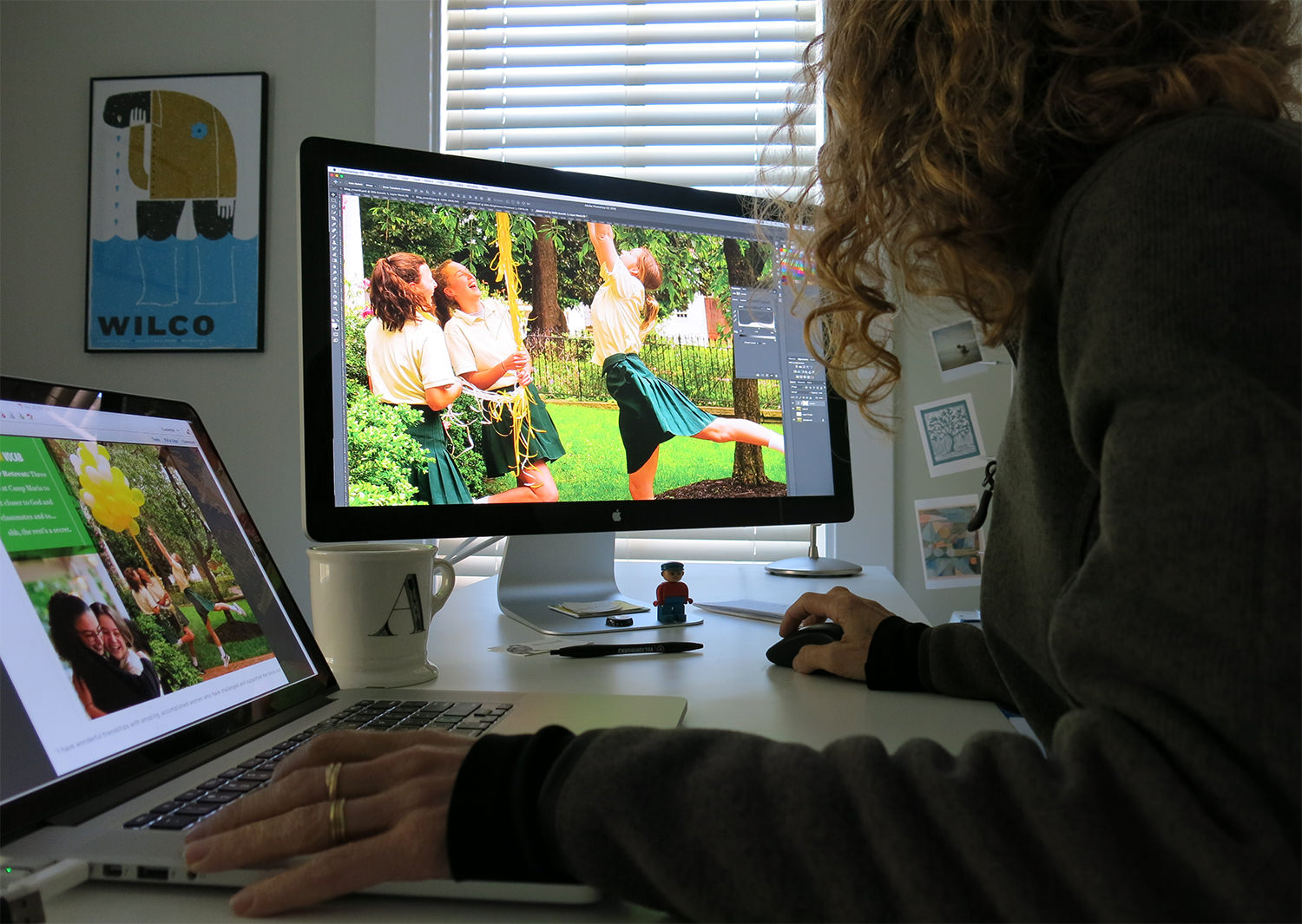Originally posted on InspirED School Marketers
This post is part three in a series of four. You can find links to the others here.
A few years ago I was working on a marketing piece and my client requested I use her printer, so I contacted him to discuss the job. Although I hadn’t sent him files yet, he assumed I was a novice. Once I started “talking shop,” he realized I had been designing and working with printers since he was a child. He began to treat me and my work with respect—especially since my files were always prepared in a way that made his job easier and the end result made everyone look good.
I can’t imagine sending a file to a printer without making it truly print-ready. Capable printing will only get your project so far if you, the designer, haven’t accounted for bleeds, margins, color conversions, and image resolution. Having said that, it takes time and experience to get to know the printing process, but here are some basic steps you should take when prepping a file for printing a four-color piece.
1. Get Your File In Order
Print out the pages at full-size
I find that viewing print layouts on a screen is ineffectual. You would be surprised at how gigantic your typography looks or how odd your design and spacing suddenly appears when a layout is printed at full-size on a desktop printer. Don’t expect to use this as a way to judge color, but do look at the overall design and hierarchy of information. Fold it into a booklet if that’s its destiny. Trim the pages out so you can see the margins. After all, the design will ultimately be printed, so print it in advance to make sure the layout looks fantastic as a printed piece — not just on screen.
Run a spell-check in your layout program
Even if everyone signed-off on the project, run one final spell check in the layout program. If you find an error, you will have saved the day. If not, it takes little time, so no harm done.
Convert swatches to CMYK
Scan the colors you are using in your palette. If any of them are RGB or spot color, you must convert them to CMYK. Remember, RGB colors are meant for screen viewing, and spot colors are meant for offset jobs that use PMS colors and flat printing.
Accommodate all bleeds
Large areas of color or big, full-bleed images can make a powerful statement. If objects or images bleed the edge of a document, make sure you extend these items beyond the page edge at least 1/8”. This goes for strokes, too. The printer will trim the excess paper and art once the piece is printed and folded.
Straighten up the elements
Check that photos and typography that are meant to align, do. Make sure that strokes are the same weight and style if that is the intention. I also like to check that columns of type align top and bottom since it makes the piece look neater.
Check margins
Text and graphics that don’t bleed should have at least ¼" margin from the page edge — ideally more. (Design tip: Don’t be afraid to use margins liberally — white space allows the eye to rest.)
Check letter-spacing
Bad letter and word-spacing on large headlines is something you will notice after your project is printed and out the door, so fix it before you give your files to the printer. It isn’t necessary to refine the spacing on all of your text, but certainly, large headlines, pull quotes and large subheads should all be checked for proper letter-spacing and word-spacing. Kern where necessary!
2. Make Your Images Shine
Once you learn how to prep your images correctly, you will start to see badly prepped ones everywhere you look in other printed publications. Be careful. Images that look beautiful on a monitor can often fall flat once ink hits paper. This is partly because paper acts like a sponge and sucks up the ink leaving your images muddy and lifeless. Here are some ways to make your images shine.
Convert RGB jpegs to CMYK tiffs
Like your color palette, your images need to be converted to CMYK if they are RGB. When printing four-color process, offset presses and digital printers operate using the CMYK color space. Artwork, graphs, and logos created in other programs should also be converted to CMYK. Hand-written signatures that are printing black should be converted to Grayscale or CMYK.
Make sure images are high resolution
On screen, images that are 72 pixels per inch look beautiful, but for print, the standard resolution is 300 pixels per inch. The inverse relationship between resolution and dimensions is not negotiable. Increasing resolution (pixels per inch) will lead to decreased image size (width and height). Unless it is a very large file, an image will be either small —and high resolution — or large —and low resolution— so use the largest files possible.
Generally, image files should be 800 KB or larger for print, otherwise you will be dealing with a low-resolution image that doesn’t have enough “information” to create a good result when printed. For instance, if someone sends you a JPEG that is 48 KB, don’t insert it into your layout and hope for the best. Ask for a higher resolution image.
Vector art, like logos and icons, should be enlarged in their original vector program if appearing larger than created. For example, a logo that is 4 inches wide that is being used at 8 inches wide in a layout should be sized up in its original vector program, such as Illustrator, then imported into your layout program. Alternatively, you can copy and paste very simple vector graphics right from Illustrator into InDesign and scale up from there as both programs support vector graphics. This process is not recommended for complex graphics with a lot of detail or that use effects such as gradients since they will slow down InDesign.
Save as a TIFF or PSD
Resaving a JPEG as a JPEG will reduce image quality. A JPEG is, by nature, a compressed file. For print, we like big files! So save your JPEG as a TIFF or PSD and remember to relink the image in your document with the higher quality TIFF or PSD.
Make adjustments
Using Levels and Color Balance (you can even dodge and burn using layer masks if you’re ambitious) lighten and brighten images that would otherwise fall flat on press. I like to pull up images that have printed well on past projects and use them as a guide while balancing color and adjusting levels. As a rule, assume that what you see on your monitor will look darker once printed.
Sharpen images
Use a Sharpen filter to make your images look crisp once printed. They may look slightly over defined on your monitor, but once the ink hits the paper, they will sparkle.
Resize (resample) TIFFs and PSDs to decrease file size
Once your high res image is placed in your document, resample the image to help reduce your document size and reduce the size of the collected files. A high res, adjusted TIFF in your document that is 50% of its size can be resampled at 50% in Photoshop. This will reduce the size (dimensions) of your image without changing the resolution (pixels per inch).
3. Get ready for delivery
Preflight
If you’re using InDesign, run the built-in preflight feature. This is your last chance to catch RGB images and missing fonts. If you adjusted images in your image adjustment program and didn’t update them in your layout, now is the time to relink or update them with the most recent, saved TIFF, PSD, or EPS file.
Collect all images, graphics, and fonts
Newer versions of InDesign give you the option to collect all or some files. You can also create a low resolution PDF during collection. If creating a small PDF, remember to name it “LowRes” as a precaution against the printer mistaking it as a print-ready document. Properly prepped layout files will be very large since they include big images, especially if you include layers in the image files. TIFFS can be 70 MB or larger depending on the height and width of the image as it appears in your document.
Alternatively, create a high res PDF
Digital printers will often use a high-resolution PDF rather than collected files. Ask your printer which settings you should use while creating your PDF from your layout program. The printer may prefer custom settings. Sometimes I send collected files in addition to the high-res PDF to my digital printer in case there is a need to alter something in the native file.
The steps outlined here may seem like overkill, but the more you can do to finesse your files and images, the better your printed piece will look. Please feel free to weigh in to share some of your file prepping ideas. Happy prepping!

